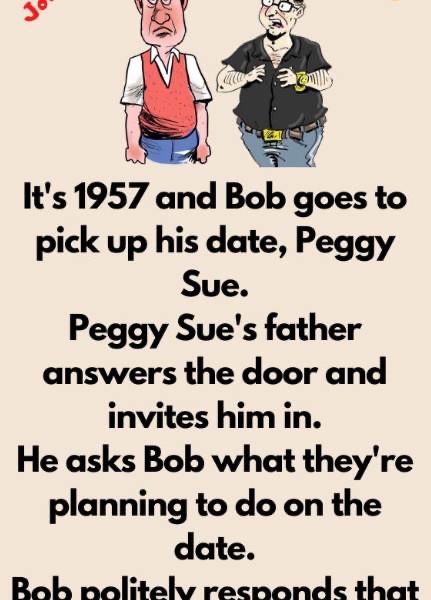Bobby Picks Up His Date: A Hilarious Misunderstanding
Bobby arrived at Peggy Sue’s house to pick her up for their much-anticipated date. As he rang the doorbell, Peggy Sue’s father greeted him at the door with a warm smile and invited him in.
While they waited for Peggy Sue to finish getting ready, her father casually asked Bobby about their plans for the evening.
Politely, Bobby responded, “We’ll probably just head to the malt shop or maybe catch a drive-in movie.”
Peggy Sue’s father leaned in with a surprising suggestion: “Why don’t you kids go out and screw? Seems like all the young folks are into it these days.”
Bobby froze, utterly taken aback. “Excuse me, sir?”
The father, unfazed, continued, “Oh, absolutely! Peggy Sue loves to screw. She could screw all night if we let her!”
Before Bobby could muster a response, Peggy Sue descended the stairs, ready to leave. She cheerfully called out, “Okay, Dad, we’re heading out!”
About half an hour later, Peggy Sue stormed back into the house, her hair a mess and frustration written all over her face. She slammed the door shut and glared at her father.
“Dad! It’s The Twist! The dance is called The Twist!”
The room fell silent, and then, well, laughter ensued.

The Humor in Miscommunication
This joke is a classic example of humor derived from miscommunication and double entendre, a literary device where a word or phrase is open to two interpretations, one of which is often risqué. The word screw serves as the focal point for the misunderstanding, creating the setup for the punchline.
Double Meaning of “Screw”:
To Peggy Sue’s father, screw innocently refers to a dance move associated with the era’s vibrant rock-and-roll culture. This highlights a generational gap; older individuals might not be aware of the slang connotation the word acquired over time.
To Bobby (and the audience), screw immediately triggers its slang meaning, i.e., a sexual act, making the father’s suggestion seem wildly inappropriate.
Situational Irony:
The joke thrives on irony. The father unknowingly says something that sounds scandalous, but his intent is completely innocent. Bobby’s reaction amplifies the humor, as he is understandably shocked, imagining that Peggy Sue’s father is encouraging behavior most parents would strongly discourage.
The Punchline – “The Twist”:
The punchline ties everything together. Peggy Sue, after realizing what her father has unintentionally implied, clarifies the misunderstanding. This reveal not only resolves the tension but also elicits laughter as the audience re-evaluates the entire situation in light of her statement.
Cultural Context:
The joke is rooted in a specific time period when dances like The Twist were cultural phenomena. These dances were wildly popular with teens but might have been unfamiliar to some adults or viewed as “rebellious” at the time.
Adding to the humor is the generational gap—Peggy Sue’s father appears to be attempting to connect with modern youth but ends up embarrassing everyone instead.

Why It Works:
Shock Value:
The father’s initial suggestion is so unexpected that it grabs attention and elicits an immediate reaction.
Relatable Embarrassment:
Many people can relate to moments when parents or authority figures unknowingly use inappropriate words or phrases, leading to awkward situations.
Resolution:
The punchline delivers a satisfying conclusion by clearing up the misunderstanding while leaving the audience chuckling at how the situation unfolded.
Broader Implications
This joke is more than just a quick laugh—it reflects how language evolves over time and how generational differences can create humorous misunderstandings. It also highlights how humor often emerges from breaking social norms or expectations in a safe, lighthearted way.
By weaving together innocence, misunderstanding, and a clever resolution, the joke becomes a timeless example of comedic storytelling.















